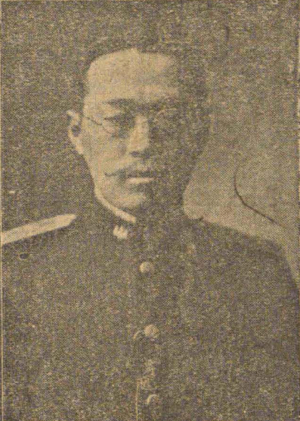Min Won-sik facts for kids
Quick facts for kids
Min Won-sik
|
|
|---|---|

Min Won-sik, 1913
|
|
| Born | July 12, 1886 Yangpyeong County, Gyeonggi, Korea
|
| Died | February 17, 1921 (aged 34) Tokyo, Japan
|
| Cause of death | Assassination |
| Resting place | Gaeunsa, Anam, Seoul |
| Occupation | Korean politician and political rights of Korean activists and right of autonomy of Korean activists. |
| Spouse(s) |
Eom Chae-deok
(m. 1906–1921) |
| Children | 1 daughter 1 adoptive son |
| Parent(s) |
|
| Relatives | Min Young-ok (adoptive father)
Empress Sunmyeong Queen Inhyeon Min Young-hwan Min Yeong-chan |
| Family | Yeoheung Min |
Min Won-sik (Korean: 민원식; Hanja: 閔元植, July 12, 1886 – February 17, 1921) was an important politician and journalist in Korea. He lived during the late Joseon Dynasty and the time when Japan ruled Korea.
Min Won-sik believed Koreans should have more political rights. He also thought they should have more control over their own country, which is called autonomy. He supported this idea even while Korea was part of the Japanese Empire. He was also a talented writer and poet. He used several literary names, including Chungam, Nankok, Handong, and Yangha.
Contents
Biography
Early Life and Family
Min Won-sik was born on July 12, 1886, in Yangpyeong County in Gyeonggi Province. His birth father was Min Young-jun. However, he was adopted by a relative named Min Young-woo.
His family belonged to the Yeoheung Min clan. This was a very famous noble family during the Joseon Dynasty. He was even distantly related to important figures like Empress Myeongseong and Empress Sunmyeong. In October 1906, he married Eom Chae-deok. She was a niece of Imperial Noble Consort Sunheon, who was a concubine of King Gojong.
Early Career
In 1899, Min Won-sik traveled to Japan. There, he taught the Korean language at the East Asia Foreign Language School. He returned to Korea in February 1905. He then became a police officer. However, he resigned from this job after only one year.
During the time when Japan had a protectorate over Korea, Min Won-sik was promoted quickly. This was thanks to the support of Japanese officials like Ito Hirobumi. In July 1906, he became the Secretary of the Ministry of Interior. Soon after, in August 1906, he also became the Hygiene Manager for the Bureau of Health and Sanitation.
In January 1910, he became the CEO of The Newspaper Current Events. Later that year, he joined a political group called Club Jeongwu. This group supported friendly relations with Japan.
Under Japanese Rule
In 1910, Japan officially took control of Korea. This was known as the Annexation of Korea by Japan. After this, Min Won-sik served on the Central Advisory Institute of the Governor-General of Korea. From the very beginning of Japanese rule, Min Won-sik argued for more Korean autonomy. He wanted Koreans to have more political rights within the Japanese Empire.
In July 1911, he was appointed Governor of Yangji County. Then, in March 1914, he became Governor of Icheon County. He often asked the Japanese Governor-General to allow Koreans to vote. However, his requests were always turned down.
From 1915 to 1917, Min Won-sik worked as a Commissioner. He was part of the Land Survey Committee for Gyeonggi Province. In September 1917, he was appointed Governor of Goyang County. In 1919, a big independence movement started in Korea, known as the March 1st movement. Min Won-sik spoke out against it. He believed that Korea could not become independent at that time. He thought the independence movement caused unnecessary violence. He felt it actually hurt the cause of getting more autonomy for Koreans. He believed autonomy could be achieved through the existing Japanese legal system.
In November 1919, Min Won-sik resigned as Governor of Goyang County. He was immediately reappointed to the Central Advisory Institute of the Governor-General of Korea.
Efforts for Korean Autonomy
In 1920 and early 1921, Min Won-sik traveled to Japan several times. He went to speak with lawmakers in the Diet of Japan, which is Japan's parliament. He met with members of both the House of Representatives and the House of Peers. His goal was to promote the idea of Korean autonomy. He wanted better rights for Koreans under Japanese rule. He stayed in Tokyo and also met with many Japanese thinkers.
However, Min Won-sik's efforts were strongly opposed by the Korean independence movement. Many independence activists did not agree with his approach.
Death
On February 17, 1921, Min Won-sik was staying at the Imperial Hotel in Tokyo. A Korean independence activist named Yang Keun-hwan attacked him. Yang Keun-hwan was disguised as a carpenter. He stabbed Min Won-sik with a dagger.
Min Won-sik was quickly taken to the Tokyo Imperial University hospital. Sadly, he later died from his injuries.
Min Won-sik's coffin was moved by boat and train for his funeral. After a service, his body was taken to Namdaemun. His funeral lasted for three days. It was hosted by his brother-in-law, Eom Ju-myeong, and his father-in-law, Eom Jun-won. He was first buried near Hongreung. A few years later, his grave was moved to the temple grounds of Gaeunsa in Anam-dong, Seoul.
Family
- Father: Min Yeong-jun (민영준, 閔泳駿)
- Adoptive father: Min Yeong-ok (민영억, 閔泳億)
- Brother: Min Yoon-sik (민윤식, 閔允植)
- Adoptive brother: Min Do-seok (민도식, 閔道式)
- Wives:
- Unnamed first wife
- Eom Chae-deok of the Yeongwol Eom clan (1889 - ?)
- Daughter: Min Chun-ja (민춘자, 閔春子) (from his first marriage)
- Adoptive Son: Min Byeong-seong (민병성, 閔丙星)
Works
Literature
- Matter of governing in Korea (조선 통치문제, 朝鮮統治問題), 1920
Art
- Muklando (묵란도 墨蘭圖)
- Mukmaedo (묵매도 墨梅圖)
- Mukjukdo (묵죽도 墨竹圖), 1914
- Kukhwa (국화 菊花)
See also
 In Spanish: Min Won-sik para niños
In Spanish: Min Won-sik para niños


